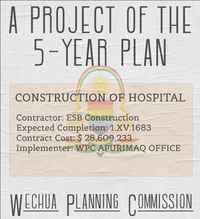Five-Year Plans of the Wechua Nation

The Five-Year Plans of the Wechua Nation are a series of social and economic development initiatives issued by the restored government of the Sapa Wechua Manco Capac in 1673 AN. After a decade of civil strife and regional warfare, the Five-Year Plans played a central role in the reconstruction and development of the reestablished Wechua state.
The Five-Year Plans were established by the Inkap Rantin Vicaquirao Alvarez through the different regional and national sessions of the Regional Committees appointed by the Sapa Wechua after the Restoration to survey and establish plans for reconstruction and development from a localized community level all the way up to the national level. These regional Committees would then send detailed plans and proposals, along with market research, economic reports, and demographic figures to the Wechua Planning Commission, which would assemble the Five-Year Plans in consultation with industrialists, historians, scientists, economists, and legal scholars. The plans have played a leading role in establishing the foundations and principles of the national and regional reconstruction plans, mapping strategies for economic development, setting growth targets, and launching political and economic reforms.
The Five-Year Plans were enacted by Alvarez with the advice of key Wechu economists, political and military leaders, and entrepreneurs. They were originally proposed by the Social Democratic Club and the Guild of Building Trades.
History
Five-Year Plans (FYPs) are centralized and integrated national economic programs. They were employed with great effectiveness in Constancia. The Constancian experience, witnessed first hand by the Sapa Wechua and the Government-in-Exile set up in Nivardom, made a big impression on the Wechu diaspora based in Constancia. It was in exile that a Committee for the Restoration was convened by the Sapa Wechua, which included representatives from every conceivable interest group in the Wechua Nation, and at the suggestion of the Social Democratic Club and the Guild of Building Trades that a national economic development program be instituted upon the recapture of the ancestral lands in Keltia.
Immediately after the capture of the ancestral lands, the restored government launched its first FYP in 1673. The FYPs are developed, executed, and monitored by the Wechua Planning Commission. With the Inkap Rantin (Wechua prime minister) as the ex-officio chairman, the commission has a nominated deputy chairman, who holds the rank of a Cabinet Minister.
First Plan (1673-1678)

The First Five-Year Plan was presented to the Council of the Nation and approved right after the Restoration, which mainly focused on the development of the primary sector.
The total planned budget was allocated to seven broad areas: irrigation and energy (27.2%), agriculture and community development (17.4%), transport and communications (24%), industry (8.4%), social services (16.6%), rehabilitation of landless farmers (4.1%), and for other sectors and services (2.5%). The most important feature of this phase was the active role of the state in all economic sectors. Such a role was justified because immediately after the end of the Wechua Sorrow and the Restoration, the Wechua Nation was facing chronic problems, with a deficiency of capital and a low capacity to save among them.
Five Institutes of Technology were started as major technical institutions. The Higher Education Grants Commission was set up to take care of funding and take measures to strengthen higher education in the country.
Planning and development of the Wechua National Redoubt were begun, complementing other defense plans created by the government and Raspur Pact military advisors.
Results
- Rimarima International Airport
- Parap International Airport
- Construction of over 1,000 large and medium-sized industrial projects, including 156 with the aid of Natopia, Alduria, Constancia, and Ransenar.
- Established the primary regulatory foundations for the sustainable and fair industrialization of the Wechua Nation;
- Developed agricultural producers’ cooperatives, while heavily subsidizing private farmers or food producers to help in the transformation of the agriculture and handicraft industries;
- Established competitive tax rates and facilitate the process to begin a business in the Wechua Nation;
- Facilitated the sustainable and properly regulated expansion and transformation of private industry and commerce in the Wechua Nation;
- Construction of a network of 800 public and private hospitals and rural clinics;
- Construction of a national highway system;
- Construction of over 400 primary schools, 300 secondary schools, and 6 universities;
- Construction of major public transport projects, including the Parap Metro Line.
Data
Second Plan (1679-1684)
This plan was created to accomplish several tasks, including:
- Expanding heavy industry in the Wechua Nation;
- Partial privatization of government-owned cooperatives and corporations, capped at 40%;
- Encouraging economic growth through industry, agriculture, handicrafts, transportation, and commerce;
- Cultivating cultural and scientific development of the Wechu people;
- Strengthening the national defense and improving living standards;
- Internationalizing measurements and other commercial standards around the Wechua Nation, providing exposure to global best practices;
- Increasing state protection and support of Wechua native culture and heritage.
Results
The Wechua government had determined that it was important for the gross value of agricultural exports to increase to help fund further rural and agricultural development. Through government policies and preferential treatment from trade partners in the Raspur Pact, the gains from 1679 to 1682 was a modest 35%. Since the beginning of the Second Plan, the country saw increases in capital construction over those observed during the first Five-Year Plan and also saw significant increases in the industry (doubling output value) and income (workers and farmers, increase by as much as 40%).